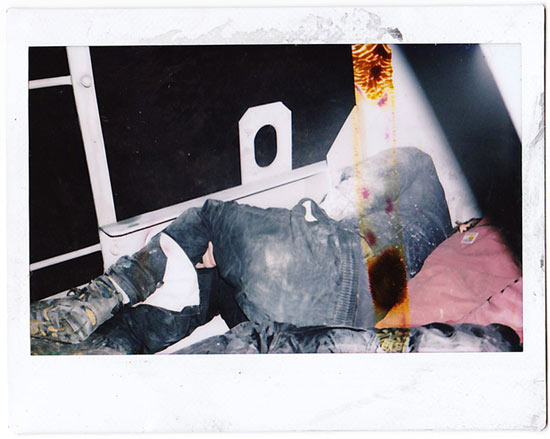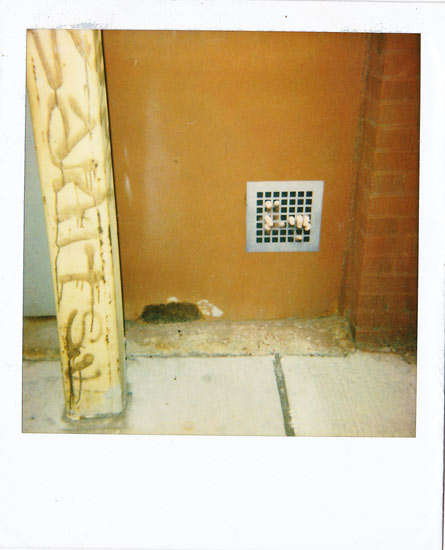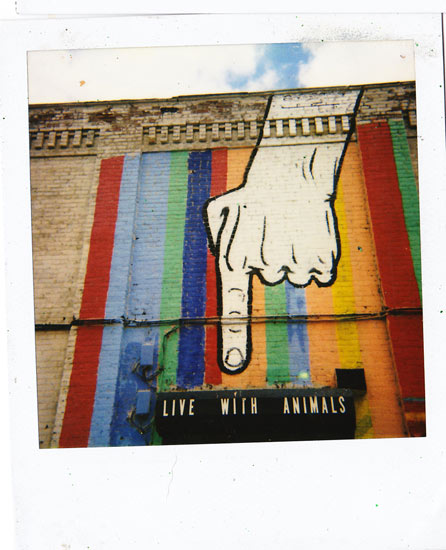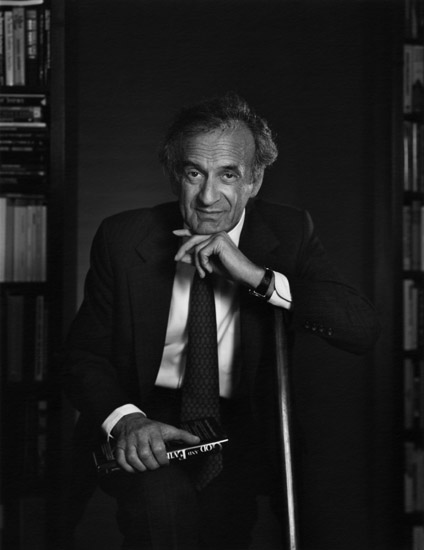 Batman, from the Melting Ice Pops series © Michael Massaia
Batman, from the Melting Ice Pops series © Michael Massaia
Remember that sinking feeling when your lolly falls to the ground in slow-motion? I guess someone dropped theirs in the gents', inspiring the wonderful machine that is
Michael Massaia to make this, his second summer series released so far this year. They are fantastic. Using a $40,000 Leica loaner, Michael Massaia's latest project entails placing ice pops on a piece of black Plexi, allowing them to melt in their own time, and photographing them using only long exposures.
Freight-hopping in the Appalachians © Adam Void
I happily scored an original piece of art by
Adam Void at
Visual AIDS' Postcards from the Edge in NYC last year - it's a well-loved event, first come-first served, you choose from anonymous artworks, you pays a little money and then discover who the artist is. Adam reached out to me soon after and has kept me updated on his multi-media artistic wanderings.
In some of his Polaroid work he travels the States shooting with the Fuji Instax (which I adore), hopping trains or driving with his mates, shooting landscapes, graffiti and so on. Here are just a few selects from his growing body of work. According to his bio, he has a BA in Existential Philosophy which makes him a right geezer in my book (that's a good thing from a Brit). He describes his work as "transform(ing) the debris of contemporary society into works that address social & political issues of class, control, and community. He is dedicated to exploring the details of countercultures particular to his experience: DIY culture, graffiti, hard traveling, social activism, mysticism, and the concept of "the outsider.""
Mr. Void has an exhibition on through July 26th, 2014, at
Castell in Asheville, NC where you could see more. Or visit his
website.
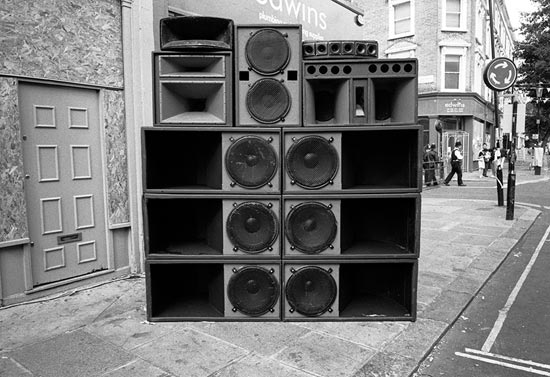
I'm loving the idea of this limited edition boxed set of prints by friend-of-aCurator
Brian David Stevens, for only £100 (that's about $170 on today's crappy exchange rate. But still a billy bargain!)
"In the summer of 2004 photographer
Stevens rose early to capture the towering speaker rigs and sound systems of the Notting Hill Carnival before the crowds arrived." Read on...
"The sound systems, these towering monuments to volume that stay in place for three days, are portrayed starkly and simply in Stevens' photos, a far cry from the colourful, loud and crowded images that normally depict the carnival. Stevens says he wanted to shift the emphasis to the source of the music that was drawing people there in the first place, and yet was drowned out in the visual noise. "Normally you never see these streets empty, they're absolutely packed with people," he says. "I got down there very early as they were setting up and shot the huge, monolithic speakers just in the middle of the street, where they look fantastically beautiful - I think every street corner should have one on them."
(Independent publisher)
Tartaruga has produced a limited boxed set of screenprints, featuring six photographs from the series screenprinted as A2 monochrome prints on to high quality archival paper.
The six prints are produced in a limited run of just 30, and come housed inside a custom printed box.
A limited photo book / zine of the series is soon to be available from
Café Royal Books, and an exhibition of the series (screenprinted by Tartaruga) is on show at
The Social in London until 30 Sept 2014.

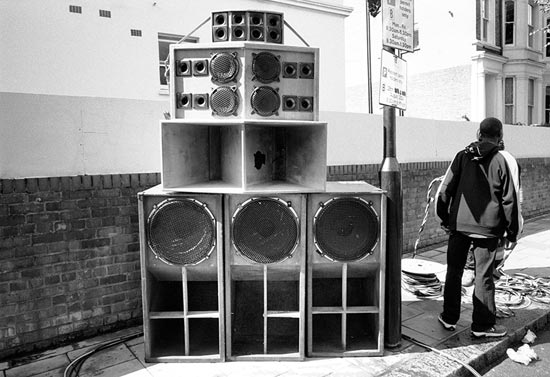


There were so many great entries for the outdoor photo installation
The Fence, now up in Brooklyn and Atlanta, and with such a limited number of spots available, a bunch of photographs that I loved didn't make the finals.
Jason Wilde was the first person I contacted when the judging had finished - I was additionally compelled by his photo of
spare ribs being eaten in the bath, and we ended up meeting on a hot day in London to talk life the universe and everything.
Jason has been collecting notes found lying around the ever-diversifying north London housing estate where he has lived for 17 years. "Built in the 1950s, the Clarence Way estate has been a focal point of London's rapidly shifting social landscape, housing people from within Britain and abroad who have been affected by any number of diverse events and circumstances. Located a few minutes' walk north of Camden Town underground station, the six orange brick blocks that make up the estate house 1297 people (2011 census) in 354 various-sized units."
"I have witnessed the rapid diversification of the cultural mix of his community. In an attempt to record this transformation, in 2003 I started collecting handwritten notes that he found discarded on the estate. On one level, these salvaged texts are simple records of the everyday; they function to remind, instruct, organise and explain. They tell of journeys planned and taken, and list items to purchase and food to take away. Some make grand political and philosophical statements whilst others are simply mysterious."
"I have photographed these once-private texts against wallpaper backgrounds, transforming them into imaginative triggers that hint at the realities of life for a diverse group of people. These individual combinations form 'Silly Arse Broke It,' an ongoing and open-ended narrative that invites the viewer to contemplate a small inner-city community that is a microcosm for the social flux and cultural (dis)integration that characterises Britain in the 21st century."
News update: Jason was accepted to the
Guernsey Photo Festival later this year, and was a winner at PhotoIreland's portfolio contest.
 Ece, Turkey. © Bilo Hussein
Ece, Turkey. © Bilo HusseinBilo Hussein is one of the delightful and impressive students from NY's School of Visual Arts I met during the class thesis review this year. Here are a few images from her heartfelt series "Never Home."
"When I was growing up in Saudi Arabia, my Sudanese parents often reminded me that the country we lived in was not our home. It was only years later that I understood the implications of this - that it might become impossible for me to 'belong' to any culture and that there was no place I could comfortably call home."
"Never Home is an ongoing project driven by the sense of segregation in religion, culture and gender that I experienced as a child in Saudi Arabia. I also express my continuing wish to find a place where I can fit in regardless of belief."
 Sakura, Japan
Sakura, Japan"As I went on to arrange and shoot the portraits, I directed my subjects to think about their formative experience in their culture of origin - on the good and the bad. I found myself almost subconsciously placing them next to a window, for reasons beyond its value as a light source. I came to the realization that they were really me sitting by the window as a child, locked up in our house in Jeddah wondering if I were ever to leave this place if would find another land I could honestly call home."
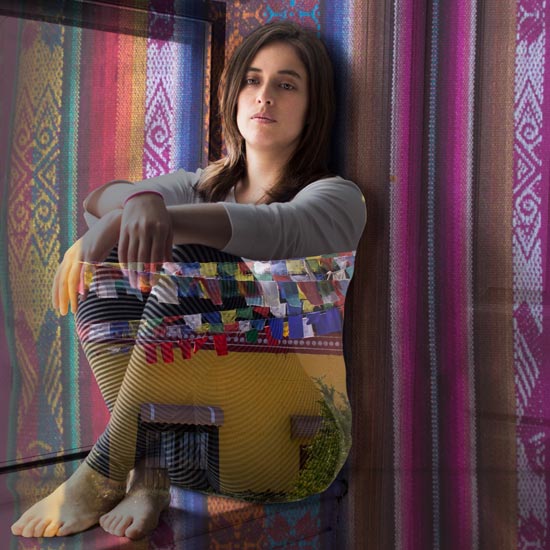 Ailin, Ecuador
Ailin, EcuadorOf course, she found much in common with the women she chose to photograph, all transplants from elsewhere, domestic and abroad. In post-production, Bilo layers images of New York that are significant to her and textures that relate to the person's original home. Simply lovely.

Solah, Korea
Yousuf Karsh "American Portraits" exhibition is still on at the
National Portrait Gallery in DC through November 4th, 2014. A representative of the
Elie Wiesel Foundation for Humanity got in touch having just seen the Wiesel portrait which is on view. The exhibition includes the colour image, but here is a black and white for good measure.
Karsh stopped working in 1992, and Mr Wiesel was among the last people photographed. Although, 1991 was still an interesting year - he also photographed Cesar Chavez, Marilyn Horne, Arnold Palmer, David Rockefeller, and Billy Wilder.
© Yousuf Karsh
 Biarritz © Pej Behdarvand
Biarritz © Pej BehdarvandLA-based photographer
Pej Behdarvand's assignment for Car & Driver magazine, to record a BMW's final moments, ("
Our Bimmer Gets Gutted") progressed into his brilliant series "Deathbed." Some of the absolute best work I see is made as "personal work" when the photographer takes their idea and executes it under their own steam. Successful projects like this can then boost a photographer's assignment work and gain them important exposure both inside and outside of the photography world.

MetroInstead of shooting the cars in the grave junk yard, Behdarvand isolated them on a black fabric backdrop, rendering them emotionally discomfiting. They are only cars, not even one you yourself have owned, yet they pull on your heartstrings and their last gasp is almost audible! Behdarvand says:
"The vehicles in this photo series are depicted as if museum objects, yet
unlike museum objects these wrecked cars are not to be physically
preserved intact for posterity, but will be crushed for reuse in another
form. The photo is the only document of the auto in this unique,
temporary state: after its useful life, before it is reincarnated into
recyclable material. What information is captured in these images? A
glimpse of the nebulous phase of a manmade thing, with remnants of
brand choice and societal status, with evidence of family and pride,
categorized indifferently with grease-pencil marks. In Deathbed, the
photo is a relic, a relic of a car relinquished to the junkyard to be
held until it is no longer a car."
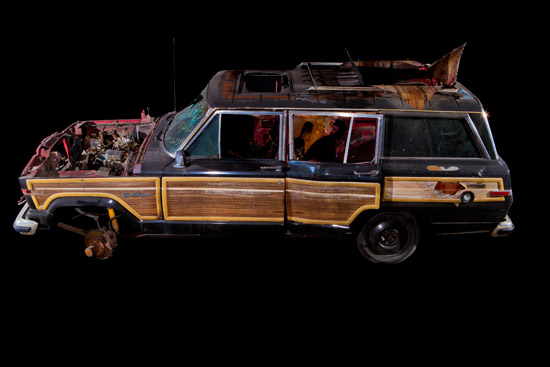 Wagoneer
Wagoneer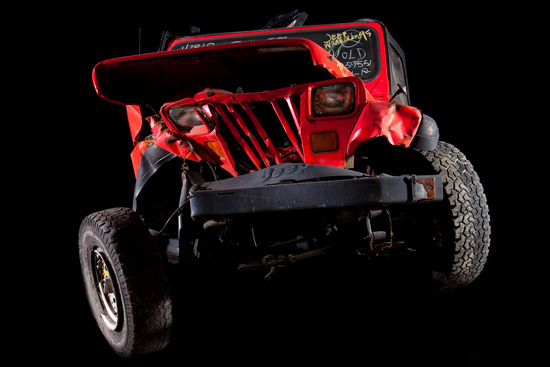 Wrangler
Wrangler Honda
Honda 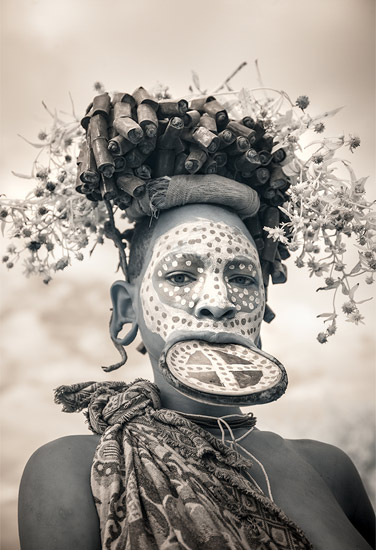 © Terri Gold
© Terri GoldIn
Terri Gold's ongoing series she explores "universal cross-cultural truths," capturing the traditions of disappearing indigenous cultures. The Omo Valley is in southern Ethiopia, in Africa's Great Rift Valley. It is known for its culture and diversity and for the discovery there of the earliest human fossils.
Terri's final prints are really beautiful. She uses very particular processes, which she describes: "I use a specially converted infrared digital camera and the digital darkroom to create my split-toned imagery. There is a mysterious quality to the invisible, iridescent world of infrared light that illuminates another dimension. When shooting, processing, and printing an infrared image, one must be open to the journey that reveals the subtle colors within. I enjoy the unexpected elements that arise when working with light beyond what the eyes can see. I also pursue the unexpected through multimedia, and often paint with encaustic wax and oils on the surface of my prints. Instead of photographic realism, I think of the work as magical realism."
But I do also think these images lend themselves extra-well to being back-lit, too!
View the full-screen magazine photo feature.
View Terri's previous feature "
Still Points in a Turning World," published August, 2010.
 Primitivo Iporre Serrano, caretaker of a pelota (ball game) court, Potosi
Primitivo Iporre Serrano, caretaker of a pelota (ball game) court, Potosi,
from the series "Salar" © Daniel HoferA few fun images from Bolivia, and Dortmund, by Berlin-based photographer
Daniel Hofer, "Born in 1982 in Düsseldorf, Germany. Great parents."
"Salar" refers to: "'Salar de Uyuni' a 10.000 square kms large salt lake, which is dried out for most of the year. It lies at an altitude of 3653 Meters in the Bolivian Andes and contains, according to the U.S. Geological Survey, one of the largest amounts of lithium in the world. Critics say that it's not possible to unify the plans for the lithium extraction, tourism and the protection of the environment in the Salar. At the moment, tourism is one of the most important sources of income to many people around the salt lake." Thanks Daniel!
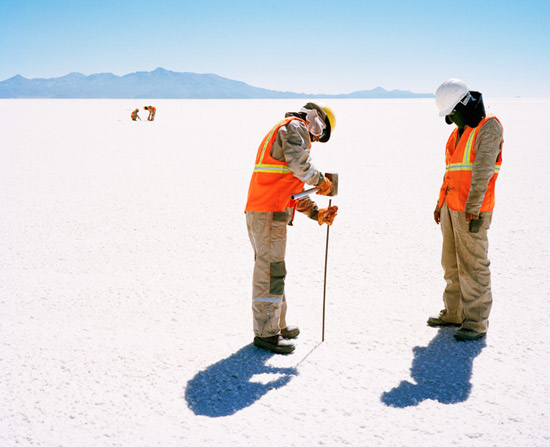 Workers who work for a state owned company that seeks to extract lithium from the salt desert are surveying at a contruction site in the middle of the Salar
Workers who work for a state owned company that seeks to extract lithium from the salt desert are surveying at a contruction site in the middle of the Salar
 Tourists undertaking guided jeep tours through the salt at lunch break
Tourists undertaking guided jeep tours through the salt at lunch break

From the series "Sunday morning," taken in the city of Dortmund, Germany, which show the members of a local pentecostal church who are mostly from Ghana.
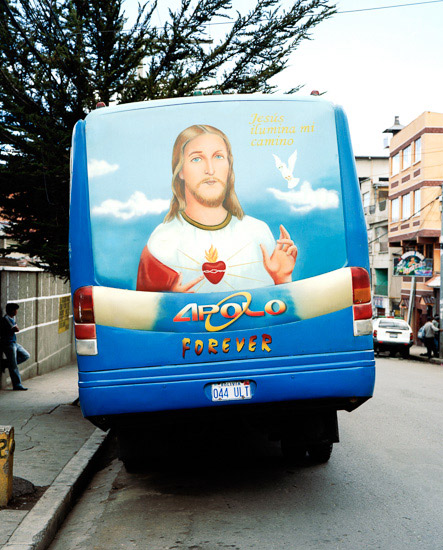 All the long distance busses that leave
from La Paz, Bolivia towards the Bolivian jungle are painted with
colorful motifs. Tigers, Christ and sexy women dominate the repertoire
of the local painters. From the series „Bolivian Busses" All images © Daniel Hofer
All the long distance busses that leave
from La Paz, Bolivia towards the Bolivian jungle are painted with
colorful motifs. Tigers, Christ and sexy women dominate the repertoire
of the local painters. From the series „Bolivian Busses" All images © Daniel Hofer
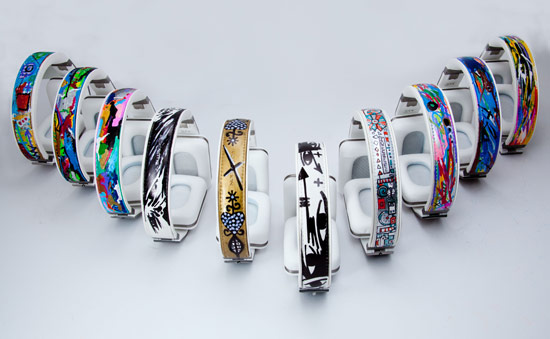
We're helping out "Headphones for Haiti" - here's some of the press release.
Monster personal audio is partnering with the Enigma Performing Arts and Convention Center of Haiti (EPAC HAITI), for the "Headphones for Haiti" fundraising initiative that will benefit the people and culture of Haiti.
As part of the initiative, Monster is donating 100 pairs of its Inspiration headphones to be used as "blank canvases" that will be hand-painted by ten renowned Haitian Master Painters, including Frantz Zephirin, St. Jean Saint Juste, Richard Barbot, Mario Benjamin, Patricia Brintle, Joseph Eddy Pierre, Yael Talleyrand, Pascal Merisier aka "Pasko", Levoy exil, Harold Dessalines, Pascale Monnin, Philippe Dodard and Patrick Ganthier aka "Killy".
Each Master Painter was given ten headphones to transform into unique, personalized works of art. Ten of the completed hand-painted headphones will also have accompanying canvas paintings by the artists, which will be auctioned off at the celebratory launch event in New York City on June 25, 2014.
The additional hand-painted headphones will be auctioned on
eBay from June 23 to July 1, 2014. All money raised at both the New York silent auction and the online auction will be used to help fund construction of the new performing arts center EPAC HAITI. In addition to helping fund this ambitious construction enterprise, the goal of the "Headphones for Haiti" program is to generate positive awareness about the art, culture and people of Haiti as the Caribbean nation continues to rebuild in the aftermath of the devastating 2010 earthquake. The "Headphones for Haiti" project is part of Monster Cares™, Monster's charitable division that was created to support local charities with education, music, sports and technology.
They look fly - get bidding!



